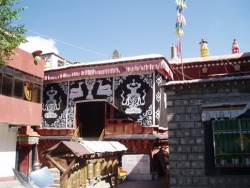Trode Khangsar throughout History
The Tibet Heritage Fund database places the origin of the Trode Khangsar building in the 17th century.26 Like most of the other temples in Lhasa, it was desecrated during the Cultural Revolution and left untended until the 1980s.
It is currently an active monastery, managed by Riwo Choling housing seven of their monks and was restored starting in 1986 (TOL, 195-196).
Unlike the Fifth Dalai Lama, the Seventh Dalai Lama, Kelsang Gyatso (1708-1757), was not involved much in secular affairs but was an erudite master.
In his collected works, there is a text on fasting (smyung gnas) through the practice of Avalokiteshvara in the tradition of the great Kashmiri nun Palmo.
Listed among those who requested this teaching are Jaya Pandita, Tagphu Tulku Lobsang Tenpa'i Gyaltsen and Lhasa Trode Khangsar assembly amongst many others.
At the time of the Eleventh Dalai Lama, Khedrub Gyatso (1838-1856), there was an Amban (an official from the Chinese Qing dynasty) present in Lhasa.
This Amban had some important matters which he brought before the Dorje Shugden oracle at Trode Khangsar. The answers to these questions were then brought to the Qing Emperor Daoguang (1782-1850). Daoguang rewarded Dorje Shugden with a pandit hat and official praise.
The Eleventh Dalai Lama, Retreng Rinpoche, the Amban, the Dorje Shugden oracle and various official monks partook of a grand ceremony in the courtyard of Trode Khangsar, and the pandit award was placed over its door (DCG, f.139-140).
A survey of Tibetan wood printing blocks in monasteries was conducted while Tagdrag (stag brag) Rinpoche was regent (1941-1950).27
Included in the catalog are contents of the various hostels (khams tshan) of the three major monasteries (Sera, Ganden, Drepung), various regent seats, various hermitages and Trode Khangsar.
It lists Trode Khangsar having wood blocks for conducting an extensive Dorje Shugden fulfilling ritual (chos skyong shugs ldan gyi bskang chog rgyas pa) authored by Ganden Jangtse Serkong Dorje Change, the most important Gelug Lama at the turn of the 19th century.
27 See Three Karchacks (Gedan sungrab minyam gyunphel series, v. 13), published 1970 New Delhi: Gangs can gyi ljongs su bka' dang bstan bcos sogs kyi glegs bam spar gzhi ji ltar yod pa rnams nas dkar chag spar thor phyogs tsam du bkod pa phan bde'i pad tshad 'byed pa'i nyin byed]].
